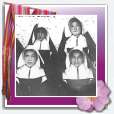 Heritage Community Foundation Presents
Heritage Community Foundation PresentsAlberta Online Encyclopedia
 |
|||||
 |
Home>> Background>>
Mission Era>> The Grey Nuns |
 |
|||
| The Grey Nuns | |||||
Upon their arrival at Lac St. Anne, home to approximately 200 people, the sisters established themselves in the house which the Oblate missionaries had made available to them. About 30 people greeted the sisters as the rest were out on the Prairie involved in the buffalo hunt—then their principal living. The Sisters were only at Lac St. Anne for five years when they moved to the mission at St. Albert. Regardless of their residence, the sisters assumed a multitude of tasks, be it teaching the people to read, write, or pray. While tending to the necessary gardening, cooking or sewing, the sisters freely taught the skills they employed to anyone who wanted to learn. They also found the time to study the Cree language, in order to converse with the locals. When the sisters were still at Lac St. Anne they prepared a 185-page grammar text which was incorporated in Father Lacombe’s dictionary of the Cree language, published in 1874.
As well as administering their affairs at the St. Albert Mission, the Grey Nuns also oversaw all of their other Western missions. Since their humble beginnings at Lac St. Anne, their numbers increased continually. Following the three sisters who went to Lac La Biche in 1862, more nuns travelled to the missions of the Athabasca-Mackenzie in 1867, where a dozen missions and several hospitals were ultimately established.2 In 1897, the provincial council of the Vicariat of the province of St. Albert oversaw the development of 10 missions and residential schools from Île-à-la-Crosse to Fort Providence, Fort Chipewyan to Dunbow in southern Alberta. The manager of all of these missions was Mother vicar Eugénie Letellier who was also the administrator of the Edmonton General Hospital. During the following years, Mother vicar Léa Dandurand opened the St. Paul Hospital in Saskatoon and the mission at Fort Resolution. Mother vicar Agnes Carroll, who had established the Holy Cross Hospital in Calgary in 1891, founded the Beauval mission between 1907 and 1910. Additional missions were established including the one in Legal in 1920.
During the 1950s, several huge projects were managed by the Grey Nuns. In 1962, a new hospital was built in St. Paul to replace the old one which was no longer adequate; a new building was constructed at Lac St. Anne, the d’Youville Home in 1966; and the Grey Nuns Regional Centre became a part of Edmonton in 1967. The more isolated regions were not forgotten and in 1967, a mission was established at Buffalo Narrows, SK; Morinville in 1971; Zenon Park, SK in 1977; as well as at Tuktoyaktuk. It was Sister Marguerite Laforce who agreed to allow the sisters to own the Grey Nuns Hospital in Mill Woods in Edmonton, which opened in 1988. Sister Faye Wylie approved the establishment of La Salle Residence in 1988, and played an important role in the establishment of St. Joseph’s College Bioethics Centre during that same year. In 1992, she was instrumental in establishing the Caritas Health Care Group in Edmonton, which regrouped all of the Catholic health institutions. The sisters also kept a nursing school to train their nurses. One must also remember that before the establishment of the welfare state, the Grey Nuns financed their own institutions. It was not rare during the difficult years of the 1930s and 1940s that the delivery of a newborn was paid for in firewood. |
|||||
|
Copyright © 2004 Heritage Community Foundation All Rights Reserved |
|||||
 |
|||||
For more on Francophone Alberta, visit Peel’s Prairie Provinces.



